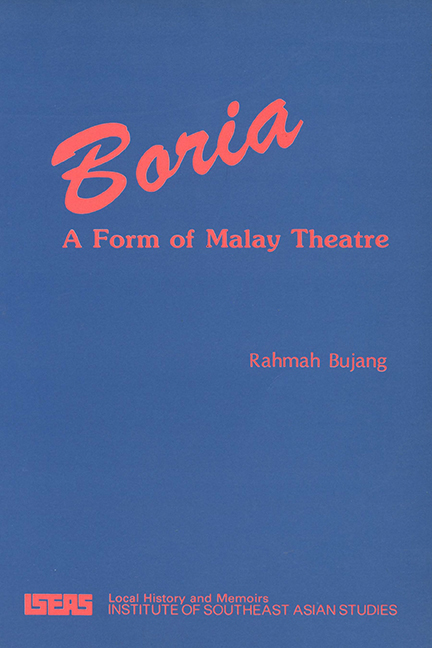7 - Conclusion
Published online by Cambridge University Press: 21 October 2015
Summary
A study of boria and its symbolism in this book has, of necessity, involved both literary and anthropological treatment in an attempt to synthesize its many facets. The method becomes unavoidable when portraying and analysing the show as a symbol of social action in an attempt to relate it to the ongoing process within its society. Within this framework boria becomes a symbol of interaction, communication and mediation that through frequent performances helps to ease and arbitrate social processes.
The Development of Boria
In sketching the development of boria as a performing art in Penang, it has been found that its popularity has since its origin been motivated by the social groups participating in it at the time. Its ancient origin was basically ritual and when the Muslim Indians brought it into Penang the form was still very much ritualistic in nature, even though Wynne viewed it as “degenerated”. Wynne's view supposed a change in its function from that of a ritual enactment of the heroism of the first Shi'ite Muslims to something more like an entertainment among the Indian soldiery in Penang. Yet the essence of the ritual was as a reminder of the schism in Islam and the original breaking up of Muslims into Shi'a and Sunni. Known then as the Muharram festival, it was a ritual of ta'ziyah meant to keep alive among Shi'ite their rivalry with the Sunni. In this the Penang version was certainly successful for Vaughan tells us that the rite was abhorred as sacrilegious by the Sunni Malays of the time.
The acculturation and assimilation of the minority Indian group by Malays through intermarriage and constant contact led to the almost inevitable change in boria. The offspring from these marriages, the Jawi Pekan, began to be involved with the Malay way of life. Yet at this point of their acculturation and assimilation they were a marginal category free to discard, adapt or adopt their parents' ways.
- Type
- Chapter
- Information
- BoriaA Form of Malay Theatre, pp. 111 - 118Publisher: ISEAS–Yusof Ishak InstitutePrint publication year: 1987



